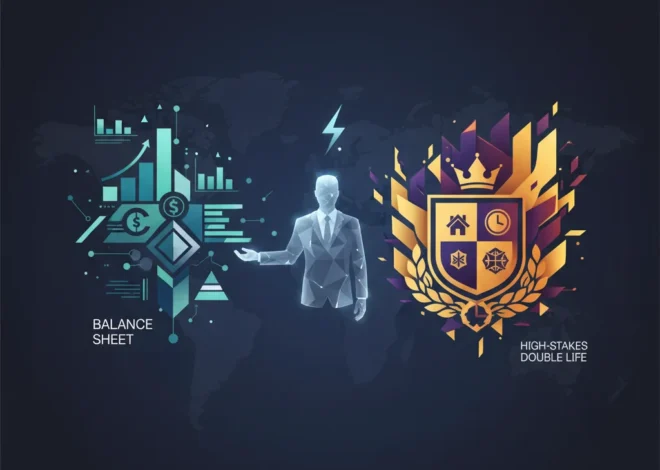
Decoding the Financial Matrix: Lessons in Strategy from the FT Crossword
For the discerning professional, few daily rituals are as intellectually satisfying as tackling a formidable crossword puzzle. It’s a mental gymnasium, a structured battle of wits where logic, vocabulary, and pattern recognition converge to bring order from chaos. The Financial Times crossword, in particular, represents a unique intersection of linguistic skill and market-savvy intellect. But what if we viewed the puzzle not just as a pastime, but as a powerful metaphor for navigating the labyrinthine world of modern finance?
The global economy, with its intricate web of interconnected assets, policies, and players, is the ultimate cryptic clue. Success in this arena, much like in solving a crossword, doesn’t come from knowing a single answer. It comes from understanding how disparate pieces of information—an inflation report, a tech breakthrough, a shift in consumer sentiment—intersect and influence one another. This article uses the framework of a crossword puzzle to deconstruct the key challenges and opportunities facing today’s investors, finance professionals, and business leaders. By understanding the “clues,” we can begin to fill in the grid and see the bigger picture of the financial landscape.
Across the Board: Establishing the Macroeconomic Cornerstones
Every seasoned crossword solver knows you start with the most obvious clues or the corner pieces to build a framework. In finance, these are the macroeconomic fundamentals. They are the “gimmes” that, once understood, provide the structural integrity for your entire investment thesis. Concepts like inflation, interest rates, GDP growth, and employment data are the long “across” clues that define the puzzle’s boundaries.
For instance, central bank policy on interest rates acts as a master key. A hawkish stance from the Federal Reserve or the ECB can send ripples across every asset class, from the valuation of growth stocks in the stock market to the viability of corporate debt. According to the International Monetary Fund, understanding the “natural rate of interest” is critical for forecasting long-term economic stability. Ignoring these foundational clues is like trying to solve the puzzle’s most obscure reference without any intersecting letters for guidance—a frustrating and often fruitless endeavor.
The global economy is a dynamic grid. A manufacturing PMI report from China provides a letter for the global supply chain clue, which in turn affects the earnings forecast for a multinational corporation. This interplay is where true financial acumen is demonstrated. It’s about seeing the connections that others miss.
The Investor's Cryptic Crossword: Decoding the Complexities of the Modern Economy
Down the Ticker: Solving the Stock Market Enigma
Once the macroeconomic framework is in place, we can turn our attention to the “down” clues—the individual sectors and companies that populate the market. This is where deep-dive analysis and strategic investing come into play. Just as a crossword might have a theme, the market has prevailing narratives: the rise of artificial intelligence, the green energy transition, or shifts in consumer behavior.
Successful trading and investing require a versatile approach. Sometimes you need to be a “value” investor, meticulously analyzing balance sheets and cash flows to find undervalued assets—the equivalent of solving a straightforward, definition-based clue. Other times, you must be a “growth” investor, betting on innovation and future potential—akin to deciphering a clever anagram or cryptic clue. Neither approach is universally superior; the key is knowing which one the current market puzzle demands.
To illustrate the difference, consider the core metrics that guide these two distinct investment philosophies. The following table provides a simplified comparison:
| Metric | Value Investing Focus | Growth Investing Focus |
|---|---|---|
| Price-to-Earnings (P/E) Ratio | Low (e.g., <15), indicating a potential bargain. | High (e.g., >30), indicating high expectations for future earnings. |
| Dividend Yield | Often higher, as mature companies return profits to shareholders. | Often low or non-existent, as profits are reinvested for growth. |
| Revenue Growth Rate | Stable and predictable. | High and accelerating (e.g., >20% year-over-year). |
| Company Profile | Established, stable, often in traditional industries like banking or utilities. | Innovative, disruptive, often in technology or biotech. |
A diversified portfolio, much like a completed crossword grid, features a mix of both. The stability of your value stocks provides the scaffolding, while your growth stocks offer the chance to solve for those high-scoring, game-changing answers.
The Cryptic Clues: Deciphering Financial Technology
No modern puzzle is complete without its share of cryptic clues—those that require lateral thinking and an understanding of a whole new set of rules. In today’s financial world, these are the innovations in fintech and blockchain.
Financial technology is rewriting the dictionary of finance. Words like “disintermediation,” “decentralization,” and “tokenization” are no longer jargon; they are active principles reshaping the industry. Fintech startups are challenging incumbent banks by offering more efficient, user-friendly services in everything from payment processing to lending. The global fintech market is projected to grow to nearly $700 billion by 2030, a testament to its disruptive power (source). For investors, this isn’t just a new sector to watch; it’s a force multiplier that is changing the operational DNA of every industry.
Then there is blockchain, arguably the most cryptic clue of all. Often conflated with its most famous application, cryptocurrency, blockchain’s true potential lies in its ability to create secure, transparent, and immutable ledgers. This technology is poised to revolutionize more than just currency; it has profound implications for:
- Supply Chain Management: Tracking goods from origin to consumer with perfect transparency.
- Smart Contracts: Automating and self-executing agreements, reducing legal and administrative overhead.
- Digital Identity: Giving individuals sovereign control over their personal data.
- Asset Tokenization: Fractionalizing ownership of real-world assets like real estate or art, making them more liquid and accessible.
Understanding these technologies is no longer optional. They are the emerging themes of the global economic crossword, and their solutions will unlock significant portions of the grid for those who take the time to learn their language.
Indonesia at a Crossroads: Prabowo, the Suharto Legacy, and the High-Stakes Game for Investors
Connecting the Grid: The Synergy of Modern Investing
The true magic of solving a crossword happens when seemingly unrelated clues begin to connect. An answer from a “down” clue provides the crucial letter needed to solve an “across” clue, and suddenly a whole section of the puzzle falls into place. The same synergy exists in finance. The most sophisticated strategies are born from connecting the dots between macro economics, market trends, and technological shifts.
Consider this example of convergence:
- The Macro Clue: A central bank announces a series of interest rate hikes to combat inflation.
- The Stock Market Clue: Higher rates make future cash flows less valuable, putting downward pressure on high-growth tech stocks that are not yet profitable.
- The Fintech Clue: Venture capital funding for cash-burning fintech startups begins to dry up due to the higher cost of capital. This leads to industry consolidation, where established financial players with strong balance sheets acquire innovative but struggling startups.
The investor who only saw one of these clues would have an incomplete picture. The one who saw the connections—the “intersecting letters”—could anticipate the consolidation trend and position their portfolio accordingly. This is the essence of modern financial analysis, as represented by the interconnected layers of the financial technology stack.
Here’s a look at how these technological layers build on one another:
| Layer | Description | Examples |
|---|---|---|
| Infrastructure | The foundational protocols and networks. | Blockchain, Cloud Computing (AWS, Azure), API Services |
| Platform | Tools and services built on the infrastructure. | Banking-as-a-Service (BaaS), Payment Gateways, Robo-Advisors |
| Application | The user-facing products and services. | Mobile banking apps, trading platforms, peer-to-peer lending apps |
As the original FT Crossword demonstrates, no clue exists in a vacuum. Every solution is part of a larger, cohesive whole.
Beyond Your Morning Coffee: Decoding the Economic Ripple Effect of Trump's Tariff Reversal
The Final Solution: Becoming a Master Financial Puzzler
The financial markets will always be the world’s most complex, highest-stakes puzzle. There will always be new clues, shifting themes, and cryptic innovations that challenge our assumptions. But like any skilled puzzler, the modern finance professional can develop a methodology for success.
It begins with building a solid framework of macroeconomic understanding. It involves the patient, disciplined analysis of individual stocks and sectors. And increasingly, it demands a fluency in the new languages of fintech and blockchain. Above all, it requires the wisdom to see the grid as a whole—to recognize the intricate connections that turn isolated data points into actionable intelligence.
The goal isn’t to know every answer in advance. It’s to build a robust and adaptable strategy that allows you to solve for ‘X’ no matter how the clues are phrased. By embracing a mindset of continuous learning and intellectual curiosity, we can move from being mere participants in the economy to becoming true masters of the financial puzzle.

